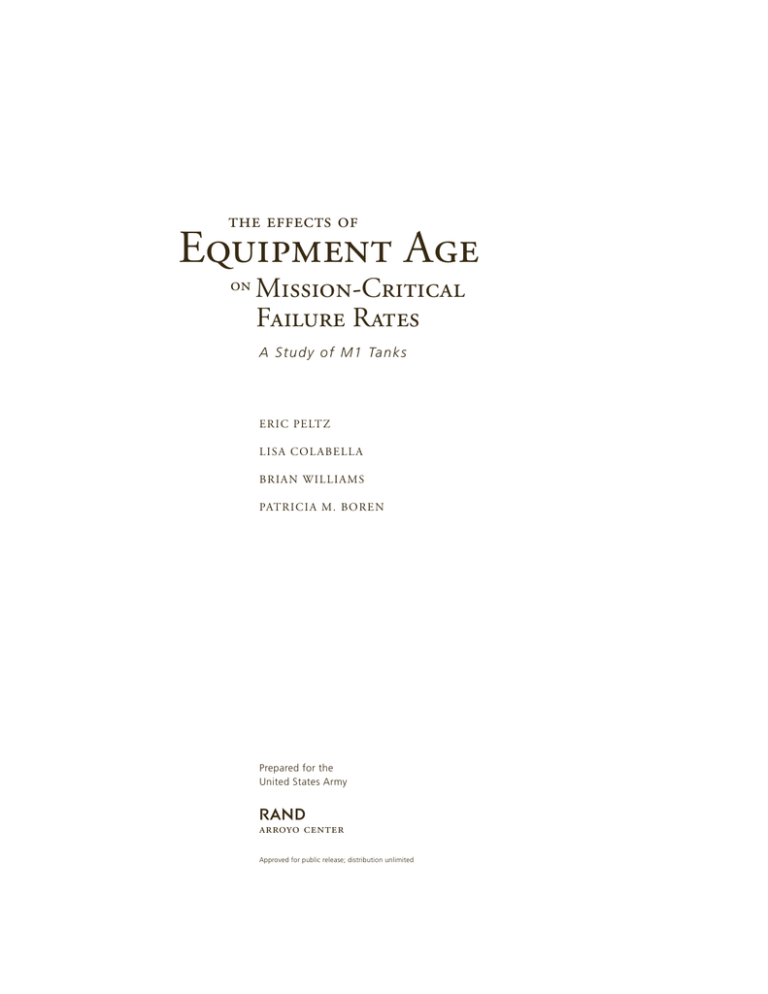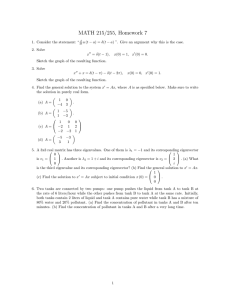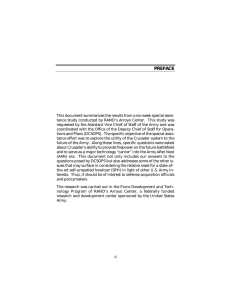
THEEFFECTSOF
%QUIPMENT!GE
ON
-ISSION#RITICAL
&AILURE2ATES
! 3TU D YO F - 4A N K S
% 2 ) # 0% ,4:
, ) 3! #/ , !" % , , !
" 2 ) ! . 7 ) ,, ) !-3
0!4 2 ) #) ! -" / 2% .
0REPAREDFORTHE
5NITED3TATES!RMY
ARROYOCENTER
!PPROVEDFORPUBLICRELEASEDISTRIBUTIONUNLIMITED
The research described in this report was sponsored by the United States
Army under Contract No. DASW01-01-C-0003.
Library of Congress Cataloging-in-Publication Data
The effects of equipment age on mission-critical failure rates : a study of M1 tanks /
Eric Peltz ... [et al.].
p. cm.
“MR-1789.”
Includes bibliographical references.
ISBN 0-8330-3493-6 (pbk.)
1. M1 (Tank)—Maintenance and repair. 2. United States—Armed Forces—
Operational readiness. I. Peltz, Eric, 1968–
UG446.5.E35 2004
623.7’4752—dc22
2004010090
The RAND Corporation is a nonprofit research organization providing
objective analysis and effective solutions that address the challenges
facing the public and private sectors around the world. RAND’s
publications do not necessarily reflect the opinions of its research clients
and sponsors.
R® is a registered trademark.
Photo Courtesy of U.S. Army by Sgt. Derek Gaines.
Cover design by Peter Soriano
© Copyright 2004 RAND Corporation
All rights reserved. No part of this book may be reproduced in any form
by any electronic or mechanical means (including photocopying,
recording, or information storage and retrieval) without permission in
writing from RAND.
Published 2004 by the RAND Corporation
1700 Main Street, P.O. Box 2138, Santa Monica, CA 90407-2138
1200 South Hayes Street, Arlington, VA 22202-5050
201 North Craig Street, Suite 202, Pittsburgh, PA 15213-1516
RAND URL: http://www.rand.org/
To order RAND documents or to obtain additional information, contact
Distribution Services: Telephone: (310) 451-7002;
Fax: (310) 451-6915; Email: order@rand.org
SUMMARY
Without a significant effort to increase resources devoted to
recapitalization of weapon systems, the force structure will not
only continue to age but, perhaps more significantly, become
operationally and technologically obsolete.
Quadrennial Defense Review Report, 2001, p. 47
Aging equipment has become a key concern of Army leaders striving
to maintain high operational readiness. Army leaders anticipate that
equipment age will pose a continually increasing challenge over the
lengthy period in which current equipment is expected to remain in
the Army’s fleet, anticipated until about 2030 in some cases, as it develops and fully fields its next generation of forces termed the future
force. In response, the Army has initiated a recapitalization (RECAP)
program to rebuild and/or upgrade selected systems, such that combat capabilities are maintained and maintenance costs are kept affordable. 1 To date, the Army plans to rebuild or upgrade 17 systems—including the M1 Abrams, M2 Bradley Fighting Vehicle, M88
Recovery Vehicle, and other systems that are expected to remain in
the inventory for the next 15 to 20 years (Brownlee and Keane, 2002;
Army Recapitalization Management, 2003). These modernization
plans continue to evolve, however. To help determine the scale of
______________
1 Rebuilding consists of efforts to restore a system to like-new condition. Upgrading is
adding components (or replacing old components with new ones) that increase a
system’s warfighting capability (Gourley, 2001).
xiii
xiv
The Effects of Equipment Age on Mission-Critical Failure Rates
RECAP required to maintain the desired level of operational readiness capability, and to facilitate RECAP program design, statistical
analyses of the relationship between age and Army equipment failures are needed.
This report describes a RAND Arroyo Center study, sponsored by the
Office of the Assistant Secretary of the Army for Acquisition, Logistics, and Technology (OASA[ALT]), on the impact of age on the M1
Abrams mission-critical failure rate. The M1 Abrams is of particular
interest because it is often considered the centerpiece of the Army’s
heavy ground forces, because it has a high average fleet age that will
continue to advance, and because it is scheduled to remain a key
part of the force for as many as 30 more years. Consequently, it has
been one of the key systems being targeted by the RECAP program.
RESEARCH QUESTIONS
The four research questions in this study are as follows:
1.
What is the relationship between age and the M1 Abrams
mission-critical failure rate?2
2.
How is the M1 failure rate related to other factors, such as usage
and location-specific factors?
3.
If there is a significant relationship between age and the M1
Abrams mission-critical failure rate, which of the various M1
subsystems and individual parts generate this relationship, and
to what degree do they do so?
4.
How can statistical models of such relationships inform RECAP
decisions and planning?
Subsequent studies will address the same questions for other critical
Army ground systems.
______________
2 A mission-critical failure is defined in this study as one that makes an item not
mission capable, as indicated by the item’s technical manual and subsequently
reported by its owning unit. Mission-critical failures are also called deadlining events.
Summary
xv
STUDY DESIGN
To address the research questions, we conducted two “substudies” at
the individual tank level of analysis. In substudy 1 (the Tank Study)
we assessed the impact of age, location, and usage on individual tank
failures. In substudy 2 (the Subsystem Study) we assessed the impact
of tank age, location, and usage on tank subsystem failures. Subsystems included actual subsystems, such as fire control, as well as
part technology groups, such as basic hardware. As an additional
segment of the Subsystem Study, we assessed the impact of tank age,
location, and usage on tank part failures, where parts (subsystem
components such as transmissions and pumps) were placed into
price categories ranging from low to very high. The samples for the
two substudies included 1,567 tanks and 1,480 tanks, respectively,3
which includes the tanks in the Army’s six active heavy divisions distributed across what we categorized as six different geographic areas:
Germany, Georgia, Korea, Kansas, Colorado, and Texas.
The age, location, usage, and failure data came from Army maintenance database extracts from April 1999 through January 2001.4 Our
primary analytical techniques included imputation of missing data
and negative binomial regression. It should be noted that data on the
maintenance history of each tank prior to the beginning of the study
period were not available. Hence, only the ages of the tanks themselves, and not their components, were known.
RESULTS
The study provides preliminary support for the hypothesis that age is
a significant predictor of M1 failures, as are usage and location. The
models suggest that M1 age has a positive log-linear effect that is
consistent with a 5 ± 2 percent increase in tank failures per year of
age. For a given location, usage, and time period, this equates to a 14______________
3 The sample in the Subsystem Study included fewer tanks because we lacked
complete data on 4th Infantry Division M1A2 subsystem failures.
4 Failure data came from Standard Army Maintenance System-2 (SAMS-2) aho01i and
aho02i files archived in the Integrated Logistics Analysis Program (ILAP), and age,
location, and usage data come from The Army Maintenance Management System
(TAMMS) Equipment Database (TEDB). Unit price data for tank parts came from
Federal Logistics (FedLog) database extracts for January 2003.
xvi
The Effects of Equipment Age on Mission-Critical Failure Rates
year-old tank having about double the expected failures of a new
tank. This conclusion only applies to the first 14 years of a tank’s life,
since most tanks in the study were 14 years old or younger at the
time of the study. (Only two tanks in the dataset were 15 years old.)
The conclusion may or may not hold beyond that point; this can be
determined as the Army’s tank fleet continues to age. In the meantime, it is risky to assume that this compound annual growth rate in
failures applies beyond the age range of our dataset.
Usage appears to have a log-quadratic effect on the mean failures of
tanks; this implies that as tank usage during a year increases, the
expected failures increase, but the rate of increase continually slows
as usage increases (in the range of peacetime, home-station usage).
Again, this conclusion is only valid within the range of the data—up
to approximately 3,000 kilometers in peacetime operations. At some
point the usage effect may become linear, with each one-kilometer
increase in usage producing the same increase in expected failures.
The magnitude and shape of the observed effects—particularly the
relationship between age and failures—differ across tank subsystems. The electrical, hardware, hydraulic, and main gun subsystems experienced larger absolute failure rate increases due to
aging than the chassis, power train, and fire control subsystems. The
chassis, hardware, hydraulic, and main gun subsystems experienced
the greatest relative increases due to aging. Because the electrical
subsystem had a high initial (age-0) failure rate, the relative increase
in its failure rate was low, despite a high absolute increase. Because
the chassis subsystem had a low initial failure rate, the relative increase in its failure rate was high, despite a low absolute increase.
Also, for some subsystems the effect of age diminished or disappeared after tanks reached a certain age, which is probably an indication that the age was beyond the normal wear point for the subsystem’s components. The point at which failures no longer increase
with age for a subsystem (or part) or actually start to decrease reflects
that point at which the peak wearout age region has been passed and
sufficient fleet renewal for the subsystem (or part) has occurred to
reduce the effective age of the fleet with respect to that subsystem (or
part).
For the fire control subsystem, our data suggest an aging effect but
also a possible effect with respect to tank variant. (Fully isolating
Summary xvii
these two effects was not possible, since age and tank variant are
confounded.) M1A2s, which are younger than M1A1s, have different
types of fire control components than M1A1s—in particular, digital
electronic line replaceable units (LRUs), rather than analog LRUs.
The data suggest that the like-new failure rate of M1A2 fire control
components is higher than that of fire control components in relatively young M1A1s.
Supplementary analyses of subsystem part failures and the unit
prices of those parts provided additional information about the
drivers of aging effects. Specifically, aging effects tended to be
stronger for low-priced parts than for high-priced parts.
Although not a focus of this study, the effect of location is noteworthy. Some locations had significantly more tank failures than did
others, after controlling for usage and age. This could be due to different maintenance practices, climate, terrain, training plans, and
failure-reporting practices.
IMPLICATIONS
Consistent with private industry fleet management principles, Army
leaders have long believed that older tanks have higher failure rates
than newer ones, which increases maintenance demands and
stresses operational readiness. However, supporting statistical evidence has been lacking. This study provides such evidence, demonstrating that increasing age, after accounting for usage and location
effects, tends to raise M1 failure rates (given the current Army maintenance regime). Although the study is cross-sectional (incorporating
one year of data from tanks), its findings—and the results of sensitivity analyses involving additional data and tests—provide initial
quantitative support for several conclusions. Specifically, it is reasonable to conclude that, without modernization, time (or age) will
pose a threat to operational readiness and increase the demand on
resources.
Another important finding is that age is harder on some subsystems
than on others. Moreover, within subsystems, age has different effects on different components. Knowledge of these patterns may
help RECAP planners determine which subsystems and components
should be rebuilt and which should receive higher priority in such ef-
xviii
The Effects of Equipment Age on Mission-Critical Failure Rates
forts. Further, the study indicates which subsystems and components are likely to drive the failure rate of new tanks—specifically, fire
control, electrical, and power train; whether new or old, these components constitute reliability “problems.” This information suggests
where upgrade initiatives such as engineering redesign might have
the biggest impact.
Further exploration of the source of age effects on the Abrams failure
rate yields valuable insights into the aging problem. Much of the age
effect tends to result from what are, in the Abrams, relatively lowcost components, so the age effect on operations and maintenance
cost (the budget account used to pay for spare parts) is likely to be
less than its effect on readiness and workload. These components are
typically simple parts that have dominant failure modes associated
with wear-and-tear. The expensive parts, in contrast, tend to be more
complex, with many different failure modes. Increased component
failures increase the maintenance workload burden. Since Army
maintainers are not paid according to the amount of maintenance
they perform and do not receive overtime, this does not affect the
Army’s cost structure. Rather, it can affect maintainer quality of life
when the workload necessary to maintain operational readiness
increases substantially.
Additionally, there are potential implications for force structure and
future operational readiness. Once tank age reaches a certain point,
the maintenance system may no longer be able to supply a satisfactory level of operational readiness—even with workarounds such as
controlled exchange, necessitating replacement or substantial rebuild or acceptance of lower readiness possibly combined with increased maintenance capacity. There is some indication that a portion of the active Army’s tank fleet has already reached this point,
causing isolated M1A1 operational readiness problems. For example,
Fort Riley units, with the oldest tanks in the Army’s active inventory,
are the only active units that consistently struggle to meet the Army’s
operational readiness rate goal for tanks. 5 At the Army’s National
Training Center (NTC), tank battalions employing relatively old
M1A1s (both NTC-owned and from home stations) averaged just 74
______________
5 From 1999 to 2001, Fort Riley M1A1 operational readiness averaged 88.05 percent,
while the active force M1A1 average was 90.75 percent, based on monthly readiness
reports extracted from the Logistics Information Database.
Summary xix
percent operational readiness over the course of rotational training
events from fiscal years 1999 through 2001; 4 of the 22 battalions for
which data are available achieved less than 70 percent, a figure often
considered the breakpoint for combat effectiveness.6 This contrasts
with an average of 83 percent for battalions with relatively new
M1A2s. Repair time for the two groups was similar, with a difference
in failure rates accounting for the difference in operational readiness
rate. Thus, for the Abrams fleet, age most likely produces gradual
workload increases, possibly resulting in decreasing soldier quality of
life and declining operational readiness, and it generates a buildup of
deferred financial cost that emerges in the form of programs such as
RECAP.
______________
6 The NTC metrics are based on manually collected data provided by NTC observer-
controllers (OC) to one of the authors. Each day, OCs collocated with tank platoons
report the operational readiness status and failure information to the Forward Support
Battalion Support Operations Officer OC, who records the information.





